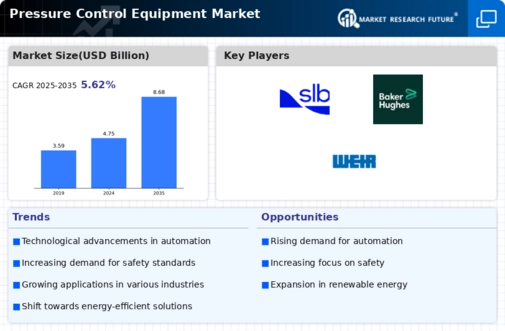Market Analysis
In-depth Analysis of Pressure Control Equipment Market Industry Landscape
The Pressure Control Equipment Market is being shaped by many trends. Digitalization and smart technologies are growing. Pressure control equipment uses sensors, data analytics, and networking for real-time monitoring and predictive maintenance. This improves operating efficiency and meets industry need for smart solutions. As firms streamline processes and get equipment performance insights, digital technologies will continue to be adopted.
Sustainability and environmental responsibility are another pressure control equipment market trend. Pressure control systems that reduce emissions and comply with strict environmental requirements are in demand as awareness of climate change and environmental effect grows. To meet customer and regulatory demands, manufacturers are investing in eco-friendly designs and technologies.
Industry 4.0 and IIoT affect pressure control equipment sales. Automation, networking, and data exchange improve production efficiency and productivity. Intelligent and networked industrial ecosystems are incorporating pressure control devices.
Pressure control equipment is becoming more customizable and modular. Industries want customized solutions. Modular pressure control systems let users customize equipment to meet their demands. This trend meets oil and gas, industry, and healthcare needs.
The market is moving toward remote monitoring and control. Recent advances in connectivity and communication allow remote monitoring and operation of pressure control equipment. Industry with remote or dangerous equipment benefits from this trend since it allows efficient operations and prompt interventions without human presence.
Rising energy efficiency concerns are affecting pressure control equipment design and development. Manufacturers are concentrating on energy-efficient technologies for cost savings and sustainability. Energy-efficient pressure control equipment supports worldwide green technology and industry carbon reduction.
Strategic partnerships and collaborations are growing in pressure control equipment. Companies are collaborating to share resources, boost market share, and exploit capabilities. By combining pressure control equipment expertise with complementing technology, producers may offer entire solutions, making the market more competitive.
Market companies are developing new materials and designs to improve pressure control equipment durability and performance. Advanced materials and technology make equipment more durable and reliable, addressing the needs of industries like oil and gas exploration in harsh settings.
Globalization is affecting the pressure control equipment market as companies expand international. Market participants looking for new prospects are targeting emerging markets with rising industrial sectors. Global expansion helps organizations diversify their consumer base, decrease geographic dependence, and compete in a changing market.






Leave a Comment